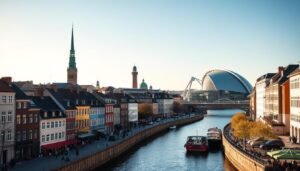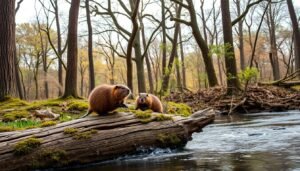More than 7 million visitors arrive each year, and many say the city feels like a postcard you can walk through.
I write this guide as someone who wanders the pastel streets, times my visits for golden light, and bookmarks favorite restaurants and coffee stops. I love showing how the compact historic core makes a long list of highlights easy to tackle on a short trip.
I’ll point out practical tips like saving spots on Google Maps, using paid garages, and where public restrooms are scarce near The Battery. My route mixes City Market and Rainbow Row with quiet alleys and water views so you get the full experience without backtracking.
Expect clear notes on neighborhoods I call home while I travel, plus a short list of can’t-miss moments and how I pace a day for photos, food, and shade under gas lanterns.
Key Takeaways
- I share a walkable route that blends classics and local picks for visitors.
- Save locations on Google Maps and plan parking to avoid fines.
- Bring water and sunscreen; restrooms are limited near the southern waterfront.
- Mix City Market stops with waterfront views and timed restaurant reservations.
- Follow my short list to get the best photos and a relaxed pace on your trip.
Stroll Downtown Charleston: King Street to Market Street like a local
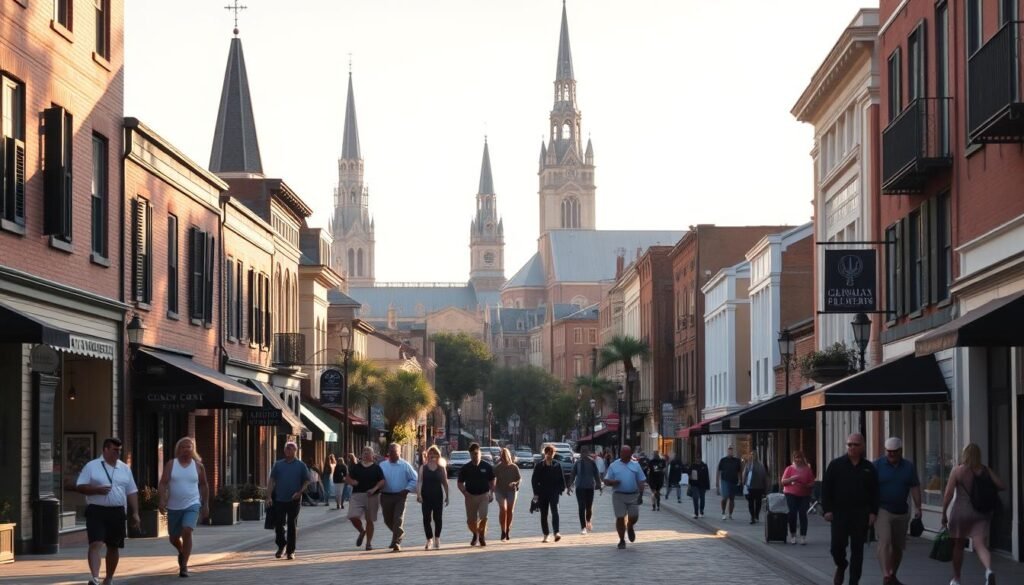
I start my downtown stroll where King Street hums with morning energy and storefronts glow under the lamps.
King Street vibes mix lively sidewalks, preserved facades, and easy people-watching. I pass the Francis Marion Hotel, a repurposed theatre now home to modern shops, and a Starbucks that kept its original bank vault. This stretch from Spring south to Broad is the main artery for shopping and brunch.
Charleston City Market spans four blocks and has been called the cultural heart since 1807. Look for Gullah sweetgrass basket weavers and authentic local craft. The market was not a slave auction site; the true locations tied to that history are elsewhere.things-to-do-in-puerto-vallarta
My walking tips: comfy shoes, sunscreen, and a downloaded map for quick restroom and shade checks. Parking? I favor paid garages and watch meters; avoid permit-only residential spots so your visit stays smooth.
I leave a flexible time window for browsing, then pivot toward Rainbow Row and the waterfront when I’m ready. That short loop keeps my camera busy and my feet happy.
| Feature | Location | Quick Tip |
|---|---|---|
| King Street shopping | Spring → Broad | Start early for fewer crowds |
| Repurposed buildings | Along King Street | Look for theatre and bank conversions |
| City Market | Market Street area | Save 30–45 minutes for browsing |
| Parking | Downtown area | Use garages; watch meters and signs |
Rainbow Row on East Bay: Charleston’s most colorful photo spot
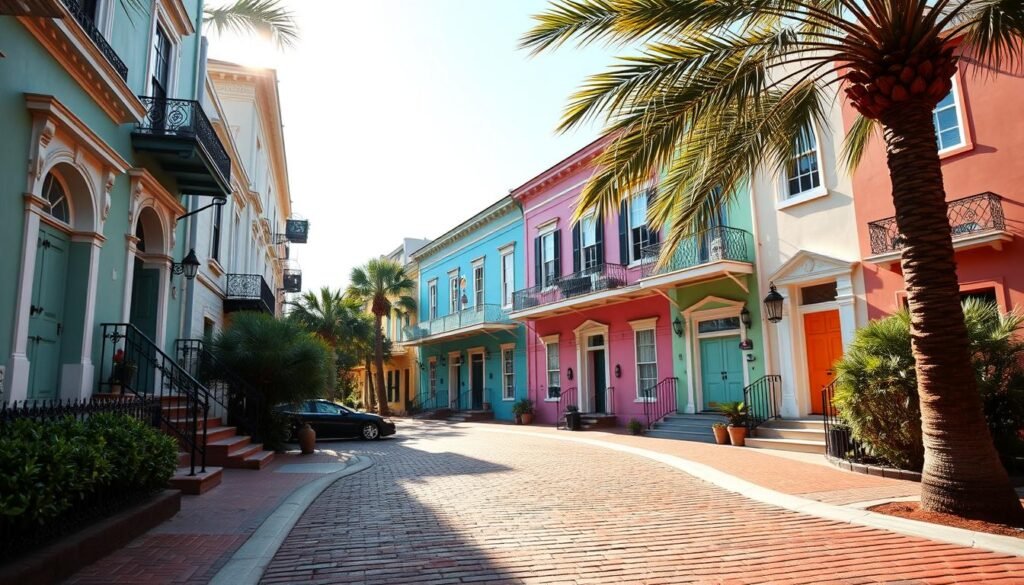
Those thirteen pastel houses on East Bay fold history and color into one perfect photo spot. I guide you straight here for the facades that define the postcard view many people chase.things-to-do-in-santa-fe
These Georgian buildings date back to the mid-18th century. Merchants ran shops below and families lived above, so the streets once mixed business with home life.
After the Civil War the row fell into neglect. In the 1930s Dorothy Porcher Legge began a careful restoration and painted the houses in soft pastels. That move revived the block and made it one of the most photographed corners of downtown.
When I shoot Rainbow Row I look for shutters, ironwork, and symmetry. Leafy trees often frame the facades, so I angle shots to include branches for depth.
“Timing is everything—soft morning or late-afternoon light reduces glare and keeps crowds low.”
I usually walk down from the shopping streets and continue toward Waterfront Park. That way you see the French Quarter, get the best angles, and reach the harborfront without backtracking.
- Best time: morning or late afternoon for light and fewer people.
- Details to notice: shutters, iron railings, and the Georgian proportions.
- Nearby: French Quarter and Waterfront Park—easy to combine on a walk.
| Feature | Era | Why it matters | Practical tip |
|---|---|---|---|
| Row length | Mid-18th century | Historic Georgian architecture | Plan short stops for photos |
| Merchant homes | 18th–19th centuries | Mixed-use streetscape | Look for shopfront details |
| Restoration | 1930s by Dorothy P. Legge | Pastels revived the block | Visit with a local history guide if curious |
| Photo notes | Any season | Tree framing and soft light work best | Avoid midday glare for truer color |
Waterfront Park and the Pineapple Fountain: harbor views and shady swings

Morning light at Joe Riley Waterfront Park often feels like a quiet invitation to slow down and look out over the Cooper River.
Start at sunrise by the Pineapple Fountain for calm water, soft color, and far fewer people. I find the fountain makes dreamy photos before the day warms up and crowds arrive.things-to-do-in-dallas-texas
The half-mile path along the shore offers steady breezes and shaded benches for a short walking reset. I usually pair this stop with Rainbow Row and the Market on the same route from downtown so I avoid backtracking.
Sunrise at the Pineapple Fountain for dreamy photos
Soft light matters. Shoot low angles to include the fountain and harbor reflections. Early time means fewer interruptions and truer colors.
Echo Stones and riverside swings: a playful pause by Charleston Harbor
I always try the Echo Stones—whisper and wait as the basin returns your voice. The porch-style swings are my go-to pause spot; I budget a quiet ten to fifteen minutes there when I need a bit of calm.
Families love the splash fountains and open lawns. That makes this an easy stop if you need a flexible spot for kids and quick photos.
- Best time: sunrise for photos, late afternoon for softer heat.
- Route tip: walk south from Rainbow Row to join the park without looping back.
- Must-test: Echo Stones and porch swings for a playful pause.
| Feature | Location | Why visit | Practical tip |
|---|---|---|---|
| Pineapple Fountain | Park entrance | Iconic photo spot | Arrive at sunrise for low crowds |
| Echo Stones | Near waterfront | Interactive sound feature | Try a whisper with friends or kids |
| Porch swings | Riverfront walkway | Relaxing harbor views | Budget 10–15 minutes per swing break |
| Splash fountains & lawns | Central green | Family-friendly play area | Great mid-day rest for active kids |
For a compact guide and more park notes, see this Waterfront Park guide that I use when mapping my morning route.
The Battery and White Point Garden: history, live oaks, and antebellum homes

I stroll the Battery at a leisurely pace, letting harbor breezes and oak shade set the rhythm.
The Battery began as a defensive seawall and now reads like a promenade that frames the southern edge of downtown. I point out where Fort Sumter sits across the water and how those long views shape the harbor experience.
White Point Garden is a shady pocket lined with live oaks, Civil War-era cannons, and monuments. I always pause under the trees for a quiet break and a history moment.
The surrounding streets show grand antebellum architecture. Rows of historic homes and ornate ironwork make this area a favorite for wedding photos and slow walking.
For photos, I time my visit for soft morning or late-afternoon light. That reduces glare on porches and brings out ironwork detail without harsh shadows.things-to-do-in-monterey
I map a simple walking loop that links the park, promenade, and nearby residential lanes so you avoid backtracking. Restrooms are scarce at this tip of the city, so I plan ahead before settling on a bench and taking in the views.
- I walk the Battery promenade for harbor views and Fort Sumter sightlines.
- Under live oaks at White Point Garden I check the cannons and memorials.
- I favor early or late light for portraits of historic homes and ornate porches.
| Feature | Why it matters | Practical tip |
|---|---|---|
| Battery promenade | Waterfront views and Fort Sumter sightlines | Start at sunrise for quiet photos |
| White Point Garden | Live oaks, cannons, and shaded paths | Bring a bottle of water and sit a while |
| Historic homes | Antebellum architecture and ironwork | Walk nearby streets for best facades |
Things to do in Charleston

I curate a short list of guided options that match whether you prefer history, food, or a little spine-tingling folklore. Pick one guided tour and a self-led route, then leave space for a long coffee break.
Walking tours, food tours, and ghost stories after dark
History tours give context you miss on your own. I book a history tour first, then add a tasting tour later if my appetite grows. Nighttime ghost tours add atmosphere and are great after a leisurely dinner.
DIY self-guided routes through the French Quarter and South of Broad
I map a loop that hits photo stops, quiet alleys, and river breezes. Small-group walking tours work well for families; they keep pace steady and offer shade notes for hot afternoons.
- I skip carriage tours because of heat and animal welfare concerns; small walking groups feel kinder and more flexible.
- Book popular tours ahead on weekends; aim for early or late time slots on hot days.
- Food tours double as restaurant scouting—perfect if you want fewer decisions later.
| Type | Why pick it | Best time |
|---|---|---|
| History tour | Layered stories on historic streets | Morning |
| Food tour | Taste local favorites and plan dinners | Afternoon |
| Ghost tour | Atmospheric evening route | Night |
For a curated list of booked tours & attractions, check this guide and choose what fits your visit charleston plan.
Fort Sumter by ferry: where the Civil War’s first shots were fired
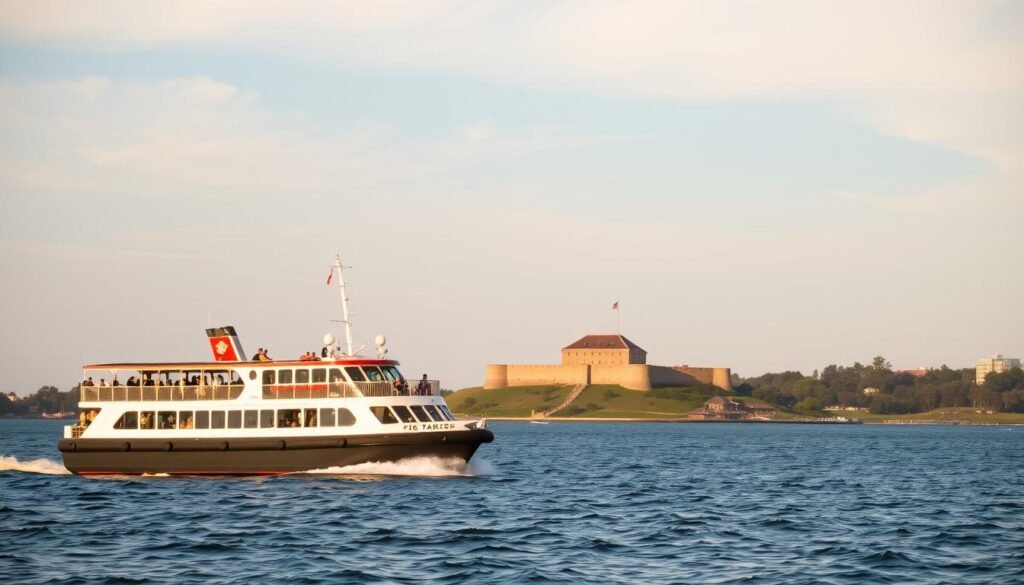
A short ferry ride out of downtown brings you straight to the ruined walls where American history changed. Adult tickets run about $35 and children around $21, and that fare includes the round-trip ferry and National Park access.fun-things-to-do
I time my trip so I can linger. Board an earlier ferry if you want quiet deck space for photos of the ramparts and skyline.
The site holds original cannons, exposed masonry, and a compact museum area with Civil War exhibits. The Visitor Center sits between the International African American Museum and the South Carolina Aquarium, which makes logistics easy for a half-day plan.
Plan for about three hours door-to-door from downtown, including a buffer for boarding and browsing displays. I bring water, a hat, and sunscreen; wind on the deck sharpens photos but cools a hot day.
I prefer morning ferries for softer light and fewer crowds. Afternoons can work, but weekend slots fill fast—book ahead if your schedule matters.
“The short ride across the harbor sets the tone: scenic, solemn, and unforgettable.”
- Best route: ferry out, walk the fort ruins, return via Visitor Center.
- For families: start at the exhibits, then explore the ramparts with kids; cannons capture attention fast.
- Pair this tour with Waterfront Park or Rainbow Row for a relaxed harbor day.
| Item | Why it matters | Practical tip |
|---|---|---|
| Tickets | Include ferry and monument access | Buy online during busy season |
| Timing | Morning = fewer people | Arrive 30 minutes early for boarding |
| Photography | Ramparts and skyline | Use the breezy deck for wide views |
International African American Museum and Old Slave Mart Museum: reckon with history
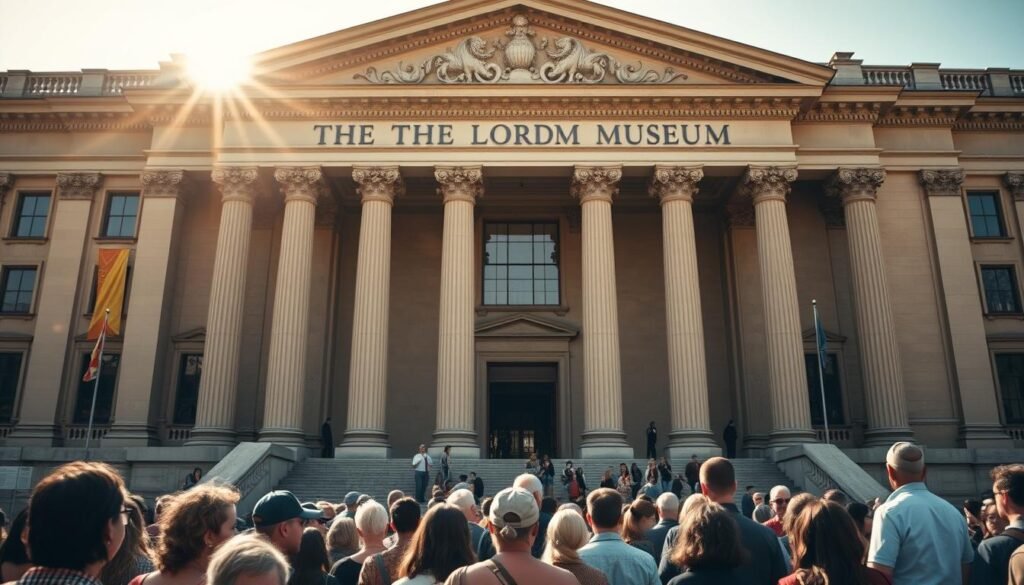
Visiting these sites calls for slow walking and a readiness to listen and reflect.things-to-do-in-cocoa-beach
The International African American Museum, opened June 2023, traces the Trans-Atlantic Slave Trade through the African Diaspora to the present day. I follow the exhibit flow and pause in the quiet rooms when I need space to process what I read and feel.
The Old Slave Mart Museum (1859) is a compact, powerful site downtown that often has descendants staffing exhibits. It focuses on primary documents and reading-heavy displays, so I plan extra time and a slow pace.
I clarify one key point: City Market was not an auction locale. Actual auctions took place near the waterfront where IAAM now stands and at the Old Slave Mart.
- I build in quiet minutes after visits so the stories settle.
- For families, I set expectations about heavy subject matter and guided reading.
- Walk the short route from IAAM to the waterfront, then loop back to the Old Slave Mart for a grounded, logical visit plan.
“These are essential stops—history told where it happened.”
| Site | Why visit | Practical tip |
|---|---|---|
| IAAM | Comprehensive exhibits and reflection rooms | Buy timed tickets; allow 90–120 minutes |
| Old Slave Mart | On-the-ground auction history | Expect reading-heavy displays; plan 45–60 minutes |
| Route | Compact downtown loop | Pair with waterfront for context and quiet |
Iconic bridges and big views: Arthur Ravenel Jr. Bridge and Mount Pleasant Waterfront Park
![]()
From Mount Pleasant the bridge rises like a ribbon across the Cooper River, and I often start there for its easy parking and quick access.
The 2.5-mile span has a dedicated pedestrian and bike path that offers panoramic Charleston Harbor views. I climb to the high point for skyline shots and a line-of-sight view of Fort Sumter in the distance.
Walk, bike, or jog the span
I usually walk to the top and return for a shorter outing. If you have the time and energy, the full crossing is a rewarding day activity.
- Start: Mount Pleasant Waterfront Park—free parking and easy access.
- Timing: early morning or late afternoon for cooler temps and less glare.
- Gear: bring water, a hat, and shoes with good grip for the incline.
- Share the path: bikes, joggers, and walkers use the same street-style route—pass politely.
“The bridge run and steady breeze make this one of my favorite short adventures for city and harbor photos.”
things-to-do-in-san-diego-this-weekend/
| Feature | Why it matters | Best time | Practical tip |
|---|---|---|---|
| Arthur Ravenel Jr. Bridge | Panoramic harbor and skyline views | Sunrise or late afternoon | Walk to the high point for shorter outing |
| Pedestrian/bike path | Safe route for walking and cycling | Weekdays for fewer people | Yield to faster riders and joggers |
| Mount Pleasant Waterfront Park | Free parking and a relaxed stop | After your walk or ride | Use swings and benches to stretch |
| Photo notes | Fort Sumter views across the harbor | Golden hour for skyline color | Pause off-path for quick shots without blocking |
If you prefer not to plan logistics, look for guided tours that include the bridge and nearby waterfront trails.
Angel Oak Tree on John’s Island: a centuries-old Lowcountry legend

I leave downtown with a hot coffee and head across the river for an hour beneath a living legend. The Angel Oak is free to visit and is estimated at 300–500 years old.
Its canopy covers about 17,200 square feet, with limbs that twist and reach low to the ground. I carve out a half-day for this spot, coffee in hand and a wide-angle ready for scale shots.
I aim for early or late arrival to avoid the largest crowds. Expect a short, respectful visit—this is reverence, not recreation.
- I note parking is small; plan brief walking from the lot.
- Kids can explore near exposed roots but please watch them and respect ropes.
- Pair this area visit with a nearby beach or a plantation for a full day.
“Use a low angle or a person in frame for scale; the tree’s reach surprises every lens.”
| Feature | Why it matters | Practical tip |
|---|---|---|
| Age | 300–500 years | Bring water and shade for a short visit |
| Canopy size | ~17,200 sq ft | Shoot wide-angle for full reach |
| Access | Short drive from downtown | Combine with beaches or plantations |
| Family note | Safe exploration near roots | Supervise children; stay off fragile areas |
Plantations with purpose: McLeod Plantation Historic Site and Gullah Geechee heritage
McLeod Plantation is one of my most important stops when I leave downtown for a reflective day trip in south carolina.
The site centers the stories of enslaved people and honors Gullah Geechee culture, not grand mansion interiors. That focus shapes every walk across the grounds.
On-site tours use first-person testimony, living-history interpretation, and guided stops that run about 60–90 minutes. Plan your visit as an educational experience, not a quick photo-op.
Admission is about $20, or free with a Charleston County Parks Gold Pass if you plan visits across the area. If you stay downtown without a car, a short rideshare takes roughly 25–35 minutes depending on traffic.
I pair McLeod with Angel Oak or a nearby beach for a day that blends landscape, culture, and quiet reflection.
Quick primer: the Gullah Geechee people kept language, crafts, and foodways alive here; their influence shapes Lowcountry homes and community life.
“Listen, ask respectful questions, and leave room for the stories you hear.”
| What | Why visit | Practical tip |
|---|---|---|
| McLeod Plantation | Centers enslaved people’s stories and Gullah culture | Book guided tours; allow 60–90 minutes |
| Pass options | Good value for multiple parks | Check Charleston County Parks Gold Pass |
| Pairing | Cultural and natural balance | Combine with Angel Oak or a nearby beach |
Charles Towne Landing State Historic Site: step into 17th-century beginnings
A short drive from downtown brings me to a broad park that marks the first permanent English settlement in south carolina.
Charles Towne Landing blends replica buildings, living-history exhibits, and an animal forest that families love. I treat it as a half-day history walk and often spend a few quiet hours following the trails.
Admission is reasonable—about $10 for adults and $6 for children—so it fits a relaxed list of neighborhood outings and longer days when you want gentle pacing.
I time my visit for morning or late afternoon when heat is low and animals are more active. I pack water, sun protection, and a light snack for trail breaks.things-to-do-in-brooklyn
Guided tours are available, and audio resources work well if you prefer a self-led route. For directions and planning, I use the official Charles Towne Landing link: Charles Towne Landing.
“This site offers a calm, readable chapter of early American history before you head back into the city.”
| Feature | Why visit | Practical tip |
|---|---|---|
| Replica settlement | Step into 17th-century life | Allow 90–120 minutes |
| Animal forest | Great for families | Plan extra time for kids |
| Trails & green space | Relaxed outdoor experience | Visit early for cooler temps |
Beach day options near Charleston: Folly, Sullivan’s Island, and Isle of Palms
Short drives bring three very different coastal moods to this area, each worth a half-day or full-day stop depending on what you want.
Folly Beach has an artsy, surfer energy and frequent free live music along the pier. I hunt for free street parking first; when lots look full I park in a paid lot and walk a few blocks. Bring a blanket, reef-safe sunscreen, and a lightweight lunch.
Folly Beach: surfer energy and live music
I love wandering the boardwalk, watching surfers, and catching an evening set when bands play. Peak weekends get busy; weekdays and early mornings feel relaxed.
Sullivan’s Island: quiet nature trails and Station 16 views
This spot is calmer. I take short walking loops, scout Station 16 for harbor views, and pack a picnic for shady dunes.
Isle of Palms: family-friendly sand and gentle waves
The free Beach Reach shuttle from Mount Pleasant runs in summer and makes IOP easy without parking fuss. Families find soft sand, calm surf, and steady facilities.
- I split time between short walks, dips, and a leisurely lunch.
- Photographers: return at golden hour for softer light and a favorite sunset spot on any shore.
- Respect dunes and wildlife—pack out trash and keep dogs leashed where required.
“Pick the beach that fits your mood and plan parking ahead for the smoothest day.”
| Beach | Vibe | Practical tip |
|---|---|---|
| Folly Beach | Surfer, music | Try free street parking early; use lots if full |
| Sullivan’s Island | Quiet, nature | Bring water and walking shoes for dunes |
| Isle of Palms | Family-friendly | Use Beach Reach shuttle from Mount Pleasant in summer |
Free and low-cost favorites: parks, galleries, farmers markets, and live music
I keep a short, wallet-friendly list for visitors who want art, music, and green space without splurging. Start with waterfront strolls and plan gallery time on an evening that fits your schedule. Small choices add up: one market run, one park bench, and a free show can fill a memorable day.
First Friday art walks, Marion Square market, and Riverfront Park
First Friday art walks bring downtown galleries open late and local artists sharing work. I chart a tight route so I waste no time between spaces and still pause for a quick snack.
The Marion Square farmers market runs seasonally on Saturdays. I pick fresh bites, then carry them to a nearby park bench or Riverfront Park for a picnic and harbor views.
Second Sunday on King, free shows, and outdoor festivals
Second Sunday on King Street shuts a block to cars, adds live music, and turns the stretch into a people-friendly promenade from Calhoun to Broad.best-places-to-visit-in-australia
Henry’s on the Market and Charleston Pour House often host free or low-cost sets. Festival season brings plenty of pop-up stages; I track schedules and plug favorites into my weekend plan.
| Spot | What | Practical tip |
|---|---|---|
| Waterfront Park | Harbor views and swings | Arrive early for quieter shade |
| Marion Square Market | Local produce & crafts | Pack a picnic blanket |
| First Friday Art Walks | Gallery openings and mingling | Map galleries ahead for an efficient loop |
| Second Sunday on King Street | Car-free walking, music | Use public transit or arrive before 1 pm |
“Stack a market stop, a park break, and an evening gallery walk for a full day without breaking your budget.”
Eat and drink: my favorite Charleston restaurants, coffee shops, and bars
I pick one splurge dinner, a reliable coffee run, and a sip stop that fits the pace of my day’s route.
Where I book dinner — Husk for refined, locally sourced modern Southern fare; FIG for an upscale, seasonal Lowcountry menu; and Bertha’s Kitchen when I want soulful Gullah Geechee comfort. I reserve Husk or FIG for weekend nights and aim for at least two weeks ahead when visitors are many.
Coffee that anchors my mornings: Harken and Harbinger serve flaky pastries and specialty drinks. Bitty & Beau’s, near the city market, is a feel-good stop and a B Corp I love supporting.
Sips and spirits: Firefly Distillery runs an affordable $13 tour with six tastings and regular live music. Holy City Brewing and Westbrook pour local favorites. I often finish at Bay St Biergarten for self-pour taps and a relaxed patio with games.
“Book dinner early, grab coffee near the market, and leave room for a tasting — that rhythm keeps my day moving.”
| Place | Why I pick it | Reservation note | Quick tip |
|---|---|---|---|
| Husk | Refined Southern, local sourcing | Book 1–2 weeks ahead on weekends | Great for celebratory meals |
| FIG | Seasonal Lowcountry tasting menu | Reserve early for prime times | Ask about veg-forward options |
| Bertha’s Kitchen | Gullah Geechee classics, comfort food | No formal reservations; plan lines | Perfect for casual, hearty plates |
| Firefly / Bay St / Breweries | Tastings, live music, self-pour fun | Firefly offers guided tour tickets | Pair a distillery tour with an evening stroll |
- I map coffee near City Market for an easy start.
- Look for lighter plates or veg choices at FIG and Husk if you prefer small bites.
- Combine a short tour or brewery stop with nearby sights for minimal walking between stops.
Where I stay in Charleston: from historic hotels to budget-friendly gems
Choosing where I sleep shapes the pace of every morning and evening on my trip. I lean toward a downtown base so I can walk between highlights and save energy for late light and dinner spots.
Mills House Hotel hits my sweet spot: stylish rooms, a rooftop pool, a sunny patio, and on-site dining. It’s a short walk to City Market and the Pineapple Fountain, which makes quick returns between outings effortless.
Classic and creative downtown picks
Francis Marion sits on Upper King Street, perfect for quick dining and shopping runs. The Vendue keeps an art-forward vibe near the waterfront and feels like a creative home base when I want galleries within minutes.
Value-friendly stays
Hyatt Place Charleston Historic District offers free breakfast, a pool, and a fitness room—great for longer days. NotSo Hostel provides private and shared rooms, a communal kitchen, and a social patio that keeps costs low without cutting convenience.
I pick a hotel by checking walk times to top stops, planning one rideshare night for farther dinners, and noting parking fees and luggage options when early check-in isn’t available.
“A central base turns extra travel time into more chances for coffee, photos, and an unhurried evening.”
| Place | Why I pick it | Best trip style | Practical note |
|---|---|---|---|
| Mills House Hotel | Rooftop pool, patio, central location | Romantic getaway | Walk to City Market & Pineapple Fountain |
| Francis Marion | Historic hotel on Upper King Street | Shoppers and dinner-focused stays | Quick access to dining and shops |
| The Vendue | Art-forward rooms near waterfront | Creative weekend with galleries | Close to harbor views and nightlife |
| Hyatt Place / NotSo Hostel | Free breakfast & pool / communal, budget-friendly | Family stays / budget-first travelers | Both are walkable to main attractions |
Practical tips for your trip: parking, heat, flooding, and getting around
My short list of travel hacks starts with reading parking signs and packing for sudden storms. I focus on choices that save time and spare a ticket or two.
Parking garages, metered streets, and free times that save a few bucks
Downtown parking is mostly paid. I favor garages marked with a “P” to avoid surprises.
Metered street spaces work well when my schedule matches posted hours. Many meters are free after 6 pm and on Sundays; always read the sign so you don’t gamble with a fine.
Beat the heat and plan for pop-up storms and high-tide flooding
Charleston summers are hot and humid. I start early, take a long indoor lunch break, and keep water, sunscreen, and a wide-brim hat handy.
Pop-up storms and high-tide flooding can change a route fast. I watch the sky and my weather app, pivot to covered stops, and avoid low-lying streets when tides rise.
Public transit is limited, so I walk most short hops and call a rideshare for longer legs or when a storm appears. Biking works on clear days.
Restrooms are scarce near the Battery; Hazel Parker Playground has reliable facilities and saves a detour.
| Topic | Quick tip | Why it matters |
|---|---|---|
| Garage vs. meter | Use garages for long stays; meters for short stops | Avoid tickets and mid-day meter changes |
| Heat plan | Early start, A/C lunch, hydrate | Keeps you comfortable and energized |
| Flooding | Avoid low streets at high tide | Prevents delays and wet shoes |
“Meters save cash when you match your time window; garages save stress when you stay longer.”
- If you head out toward Mount Pleasant, leave before peak return windows and use park-and-walk lots.
- Pack a lightweight rain shell and a small towel for sudden ponding on streets.
- My quick checklist: meters, maps, water, hat, and a backup rideshare plan.
Conclusion
This guide ends with a simple plan that helps you mix history, beaches, food, and quiet river views across downtown and beyond.
I suggest slotting Rainbow Row, the Pineapple Fountain at sunrise, and The Battery’s shaded strolls around a dinner reservation. Add a ferry day for Fort Sumter and carve out reflective time at IAAM and the Old Slave Mart Museum.
Keep City Market and a coffee stop near your loop so a snack, shade, or a quick photo is never far. Balance paid attractions with free picks—art walks, farmers markets, and Second Sunday on King—so your days feel full without overspending.
Use this post as a pocket guide: pick a morning, map one walk, and book one dinner. Whether this is your first trip or your fifth, there’s always another place to linger and another view to chase.
Ready to visit charleston? Map a route, save a few spots, and let the city reveal its stories at your own pace.












